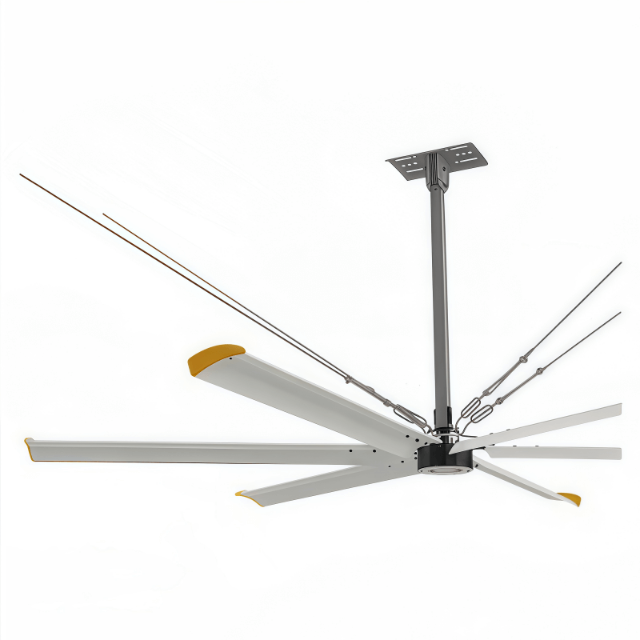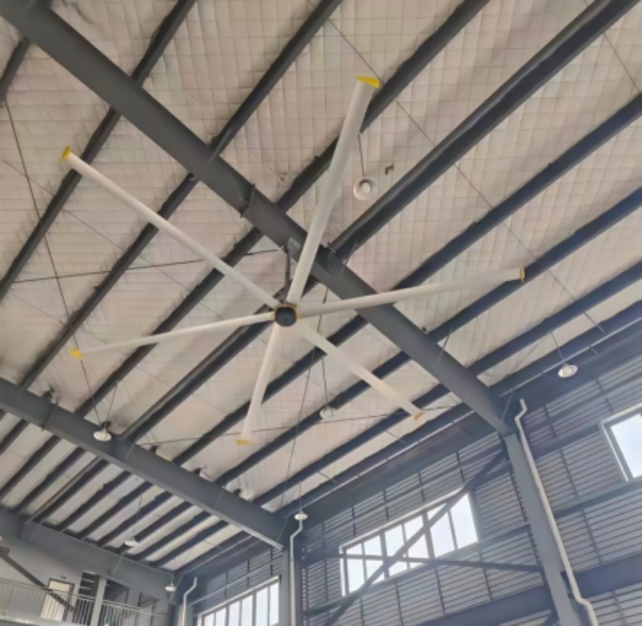How HVLS Ceiling Fans Cut Cooling Costs in Large Warehouses

Introduction
Running a warehouse means facing one constant headache: high cooling bills. In hot seasons, heat piles up under the roof. Normal fans or vents just push warm air around. Air conditioners end up working too hard, and energy bills shoot up. One answer many managers rely on is the HVLS ceiling fan. HVLS means High Volume, Low Speed. These fans are made to move huge amounts of air while spinning slowly. With steady air circulation, you get a cooler and more balanced space, your HVAC system gets a break, and you save real money on power.
What Makes HVLS Ceiling Fans Different?
Small fast fans can only stir up limited air. HVLS ceiling fans are on another level. Their blades are wide, sometimes stretching over 7 meters. A single turn pushes down a column of air that spreads across the ground and circles back up the walls. This simple loop repeats again and again, keeping the whole building in motion.
Blade Size and Air Volume
Take the DH-860 model. It comes with blades that reach 8.6 meters across and delivers up to 15,800 m³ per minute of airflow. Mid size versions still manage about 10,000 m³ per minute. One unit can cover nearly 1,800 square meters. To get that same reach with small fans, you would need dozens, all burning far more power.
Quiet but Strong
Big spaces don’t need extra noise. HVLS ceiling fans move slowly, about 48–64 rpm, yet push a strong breeze. Noise stays low, only 38–39 dB. That’s quieter than people chatting in an office. This is why they fit well not just in warehouses, but also in gyms, sports halls, or even event venues.
How HVLS Fans Reduce Cooling Costs
Supporting HVAC Systems
Air conditioners always struggle with trapped heat layers. Cool air sinks, hot air rises. Without circulation, the system wastes energy. HVLS fans stir everything together, so the HVAC doesn’t overwork. In many cases, this cuts AC costs by 20–30%.
Replacing AC in Mild Seasons
In spring or autumn, you may not need full air conditioning. HVLS fans alone can drop the “felt temperature” by up to 8°F. Workers feel cooler thanks to the steady breeze. This comfort means you can keep the AC off more often, saving serious money.
Reducing Heat Stress
Heat stress is more than an expense, it’s a safety risk. When air is stale and hot, workers tire faster, and stored goods spoil quicker. HVLS fans keep the warehouse balanced, lowering health issues and protecting products.
Applications in Large Warehouses
No two warehouses are alike. Some are full of tall shelves, others handle bulk storage. HVLS fans bring value in all of them.
Distribution Centers: Avoid hot pockets high up near racks.
Cold Storage Entry Points: Cut down sharp swings when doors open.
Packing Areas: Give steady cooling for staff on the line.
Bulk Storage: Guard goods from heat and moisture changes.
Product Spotlight: Industrial HVLS Ceiling Fan
A strong option is the Industrial HVLS Ceiling Fan. It uses a permanent magnet brushless motor, combined with slim alloy blades built with advanced molding. The design keeps the fan light yet tough. Airflow spreads to areas of 1,800 m², making it a fit for very large spaces.

Why Blade and Motor Technology Matters
High Performance Blades
Blades made from aluminum copper magnesium zinc alloy are tough but light. They are pressed in one piece, so there are no weak spots. That means fewer breaks or cracks, even after long use.
Permanent Magnet Motor
Permanent magnet motors replace older induction styles. They waste less energy, handle a wide range (50–60 Hz), and run smoothly. Because they don’t heat up much, they last longer and cost less to run.
Safety Systems
Every HVLS fan needs strong safety. These units use reinforced mounts, sealed ABS control boxes, and automatic shutoff if anything goes wrong. That lowers the risk of accidents and downtime.
Introducing Daiho Equipment
Located in Foshan, Guangdong, Daiho Equipment makes cooling and ventilation tools for heavy duty use. The company builds full cale systems for warehouses, livestock barns, and commercial spaces. Besides HVLS models, you’ll find vertical air circulation fans for tighter airflow needs. Daiho also provides custom project designs and on site services to match real world conditions. Many projects are shared in their case center, showing how clients cut costs and improved comfort.
Comparing HVLS Fans With Vertical Air Circulation Fans
HVLS fans cover broad zones. Vertical air circulation fans focus on tough spots. For instance, in a warehouse with tall racks, hot air lingers at the top. A Vertical Air Circulation Fan can drive airflow through those blocked areas. Many facilities use both styles, HVLS fans for wide coverage and circulation fans for exact control.
Real World Example
Picture a warehouse storing packaged food. Before, air conditioners ran all day, yet staff still felt warm. After two DH-800 fans went up, airflow evened out. The AC ran fewer hours, bills dropped by a third, and workers reported cooler shifts. The setup paid for itself quickly, and the comfort gain was clear.
Long Term Benefits Beyond Cost Savings
Energy savings are the headline. But HVLS fans bring more.
Cleaner Air: Steady flow dilutes dust and fumes.
Happier Staff: People feel less tired when air moves.
Equipment Protection: Stable conditions help machines last longer.
Smart Design: White blades with yellow tips look modern, not clunky.
FAQ
Q1: How much can HVLS fans reduce cooling costs?
A: With the right layout, savings often hit 20–30% of your normal energy bill.
Q2: Can one HVLS fan cover an entire warehouse?
A: A single unit covers about 1,800 m². Large buildings may need several to reach all corners.
Q3: Are HVLS fans safe to use in crowded areas?
A: Yes. Low noise, steady mounting, and auto shutoff features keep them safe in warehouses, gyms, and event spaces.
Q4: What is the difference between HVLS and vertical circulation fans?
A: HVLS fans move air across wide zones. Vertical circulation fans send focused streams into tight or blocked spaces.
Q5: Why choose Daiho Equipment for warehouse cooling?
A: Daiho supplies industrial fans plus project services and cooling solutions. Their fans and case studies prove performance in real facilities.
